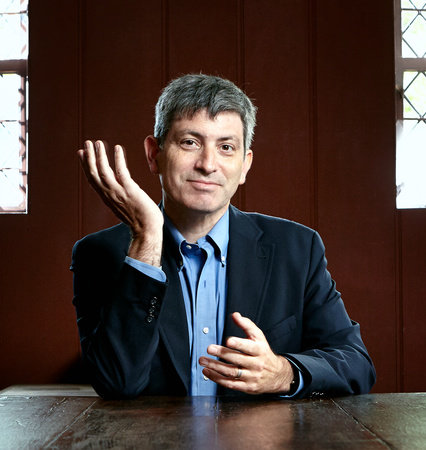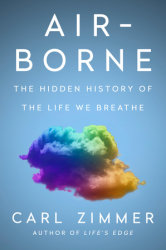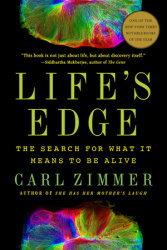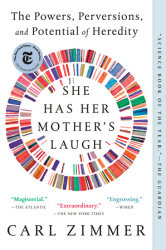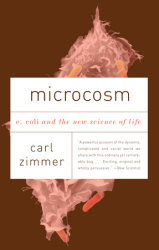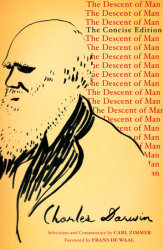Carl Zimmer writes the “Matter” column for The New York Times, and has frequently contributed magazines such as The Atlantic, National Geographic, Wired, and Scientific American, among others. A frequent contributor to Radiolab, he is the author of numerous books about science, most recently She Has Her Mother’s Laugh, a book that seeks to understand what exactly gets passed down from generation to generation. Read on for a Q&A with Carl Zimmer about the research he did for his book, and what he learned along the way.
PENGUIN RANDOM HOUSE:How did you first become interested in the topic of heredity?
CARL ZIMMER: I’ve been fascinated by heredity for as long as I can remember, but I think all of us are. As a science writer, I have to explain what meiosis is, but I don’t have to define heredity. We all wonder about our ancestors–who they were, how they lived, and how countless generations of lives came together to produce us. We compare children to their parents and their grandparents, searching for what they inherited — not just their eye color, but their height, their personality, and every other imaginable trait.
But when my wife was pregnant with our first child, heredity became a matter of urgency. What would my child inherit from me, I wondered? And how would that inheritance get carried down to future generations? As a journalist, I’ve reported for the New York Times about a lot of advances in our scientific understanding of heredity in recent years. One day I decided to dive deep into all that science and history, and — after a lot of work — I had written this book.
PRH:You write that we need to change the way we think about heredity. How do you define it? What are some of the most pervasive myths about heredity?
CZ: For centuries, people believed in the power of blood. People inherited their nature through blood — royal blood, noble blood, and so on. Curses were carried down in the blood, too. In the 1500s, the modern concept of race emerged, based again on the heredity of blood (hence the “one drop rule” for race in the United States).
We know now these concepts don’t make biological sense. We don’t inherit blood, but we do inherit genes. Yet we still talk about genes in the same way we talked about blood. I’ve heard friends talk about getting 23andMe tests, excited to discover that they have “Irish DNA.” They talk about it as if it explains how their life has turned out.
An obsessive focus on genes also prevents us from seeing the other channels through which heredity can flow. When we teach children, we are passing down culture — which is no less important than the DNA they inherit. Microbes infect their hosts and get passed down through the generations. It’s possible that some molecules aside from DNA may get passed down from parents to children.
The best way to think about heredity is what the past gave the present, and what the present will pass down to the future.
PRH:You are the first journalist to get your genome sequences and explore it scientifically. You’ve even posted it online for scientists and students to analyze if they so wish. How did the results stack up to your expectations? Any advice for people who are considering genetic testing like AncestryDNA or 23andMe?
CZ: We think of our DNA as the book of life. If we just open it up, we can read our truest selves. But that’s not true. There are millions of tiny differences between my genome and yours, and scientists are only starting to figure out how those differences matter to our health, our personalities, and other aspects of our lives.
For example, 23andMe can tell you what percentage of your DNA comes from Neanderthals. That’s all well and good, but what really matters is which parts of your DNA comes from them. Yet even if you can find out — as I did — the meaning of that inheritance still remains a mystery. I’ve discovered that my Neanderthal DNA is associated with a risk of bloody noses and toe deformities, for example. It’s hard to know what to make of that, given that my nose doesn’t bleed a lot. Also, my toes look pretty nice, if I do say so myself.
My advice for people who are thinking of getting AncestryDNA or 23andMe tests is to prepare both to be shocked and to be bored. If your test delivers information on genetic diseases, there’s a very small chance that you may find that you have a mutation that is a serious threat to your health. If your test doesn’t find any medical conditions, that doesn’t mean that you don’t have any harmful mutations. It only means that your particular test didn’t find any.
Some companies try to juice up their test results by telling you about traits that don’t have to do with disease. But these results can be underwhelming. When my wife took a 23andMe test, she learned that she is “likely” to have blue eyes. She has, in fact, a 100% chance of having blue eyes.
Genetic testing can also give clues about ancestry. Those results may tell you what you already knew — or give you a surprise. According to one analysis of my genome, I have a lot of southern European ancestry. That goes against a lot of genealogical research my relatives have done. So either their research is wrong, or there’s a big secret someone needs to explain to me. Or maybe the genetic test itself is wrong. These ancestry tests are still in their early days, and their results are crude. They depend entirely on how many people and populations a testing company compares you to.
As these companies add more people to their databases, they’re going to get better at determining people’s ancestry. And they are already very good at identifying close relatives. (An open-source DNA-sharing site already revealed the Golden State killer’s relatives, for example, leading to his arrest.)
From time to time, people who used these tests are discovering that their families have been hiding some deep secrets. Again, this is not likely to happen, but you have to be ready for the small chance that it will.
PRH:Is it possible I’m related to Charlemagne or Cleopatra?
CZ: Yes, but I’m afraid it doesn’t make you special.
We envision our ancestors like infinitely dividing branches — two parents, four grandparents, eight great-grandparents, and so on. But if that were truly the case, then a few thousand years ago, your own ancestors would outnumber all the humans who ever lived. In fact, our ancestors are related to each other, joining those branches together. The shape of our family trees gives rise to some remarkable facts. Charlemagne is the direct ancestor of all living Europeans, for example. And Cleopatra may be a direct ancestor of all living humans.
PRH:What surprised you most during your research for the book?
CZ: Heredity is full of surprises — it just won’t follow our intuitions. For example, we assume that we inherit DNA from our ancestors. After all, in each generation genes get copied in and passed down to the next one.
But it’s not as simple as that. People carry two copies of each gene, inherited from each parent. When they have children of their own, each of those copies has only has a fifty-fifty chance of getting passed down. Repeat this selection over many generations, and something surprising happens: some people’s DNA disappears altogether from some lineages of their descendants.
Pick one of your ancestors from 10 generations back, scientists have found, and there’s about a fifty-fifty chance that you inherited none of their DNA. They’re still your ancestors, but you have no genetic connection.
PRH:There’s been a lot of debate recently about how intelligence is inherited, and whether there are inherited differences between races. You write about the current controversy, as well as its deep history, in your book. What’s your take on the debate?
CZ: A lot of what I hear these days betrays a deep ignorance of the science of heredity and intelligence. Some people want to claim that intelligence has no significant biological basis. That simply isn’t true. There’s lots of evidence that how people do on intelligence test scores reflects other aspects of their lives, including things we don’t usually associate with intelligence. An intelligence test score predicts how fast you can press a button when you see a certain shape, for example. It also predicts how likely you are to get inti a car crash. Intelligence tests given at age 11 predict how likely people are to still be alive at age 79. We don’t know what those underlying connections are, but they definitely exist.
It’s also clear that genes play a role in the different test scores people get. This has emerged from many different kinds of studies — from studies on twins raised in separate families, for example, as well as from studies of the DNA of hundreds of thousands of unrelated people.
It may seem logical to conclude that intelligence is entirely a matter of which genes we inherit. But that’s not how heredity works. It’s possible for a trait to be strongly influenced by variations in genes—and also be influenced strongly by the environment. Intelligence test scores can be influenced by everything from lead in people’s houses to iodine in their food to the number of years they stay in school.
Intelligence is no different from other traits in this regard. In my book, I show how intelligence is a lot like height. Both are influenced by many genes. Both are strongly heritable. But both can also be altered by the environment. Across the world, people are far taller now than they were 100 years ago. Their genes didn’t change. Their lives did — generally for the better.
It’s an even bigger error to then jump from research on intelligence to the claim that different average test scores in groups of people must be due to genetic heredity. The research on intelligence is limited to the variations between individuals within groups (like, for example, the children born in Scotland in a single year). You simply can’t leap-frog to claims about the cause of differences between groups.
Another problem with these claims is how we define groups of people. Debates about intelligence usually come down to the question of race. But in 2018, we still use a pre-genetics language of race. “Race” took on its current meaning in the 1500s, in the context of persecution. Jews in Spain were defined as a separate race from “Old Christians.” Native Americans and Africans were then defined as races as well, as Europeans invaded the Americas and gained huge profits from slavery. Theologians claimed that blacks inherited their enslaved status along with their dark skin, as the curse of Ham in the Bible.
Now that we can look at human genetic diversity, scientists are exploring the variations across the planet. The categories of race have little use to them. One scientist I spoke to compared them to the ancient Greek elements of air, water, fire, and earth. Modern science doesn’t deny that air exists. It just recognizes it as something fundamentally unlike what the Greeks imagined. Continuing to use the Greek elements would send science back thousands of years. Geneticists have no interest in making the same mistake.
